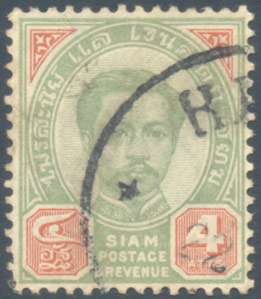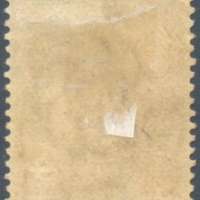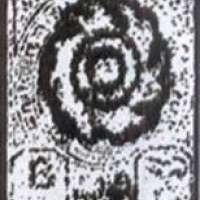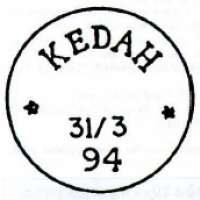STAMP PHILATELY
Kedah using Siamese 4 Atts (1887)
GENERAL INFORMATION
State
Kedah
Country
Thailand
Type
Stamp (Single)
Class
Definitive / Regular Issues
Front Inscription
4 ATTS SIAM POSTAGE & REVENUE ไปรษณีย์ และ เงินตรา สยาม ๔ อัฐ
Face Value
4 Att
Issued Date
01/04/1887
Printing Method
Typography
Gum
Gum
IN COLLECTION CONDITION
Preliminary
Normal
Condition
Used With Postmark - Very Fine
CATALOG INFORMATION
Z9
Gibbons Stamp Catalogue Commonwealth & British Empire Stamps (1840-1952)
14
Scott Standard Postage Stamp Catalog
Kedah using Siamese 4 Atts (1887)
Siam (Modern day Thailand) stamp used in Kedah
Second Issues (?)
Value: 4 atts
Color: Green & orange-brown
Watermark: Chakra
Issued from 1887 until 1891
Hinge residue on the back.
The postal history of Kedah, according to philatelic experts, started in or around April 1887 to October 1887. First known postmark from Alor Setar post office was 25 October 1887.
It started when Siamese stamps and postcards were sent to Penang in 1887. During this period of about 25 years, Siamese stamps were used in Kedah for postage purposes. The services were under management of posts and telegraphs department.
Other post offices were opened at Kuala Muda (3 October 1907), Kulim (7 July 1907) and Langkawi (16 February 1908).
Thai Characters
ไปรษณีย์ และ เงินตรา สยาม
Postage and Currency of Siam
๔ อัฐ
4 ATTS
Circle date stamp (CDS). Single ring with date at foot.
Only partial KE was seen and partial date, 22.
Kedah was known Syburi (Thai: ไทรบุรี; Pronunciation: Sai Buri) meaning "City of Banyan" by the Siamese when it was under their influence.
Kedah have ever been one of the tributary states of Siam. The Siamese overlord Kedah, but recognize it as a country with its own administration. Siam had the tributary states in the Malay Peninsula until 1909. These tributary states were Malay Sultanate states that became Islamized in the 15th century. However, Ayutthaya, the Court of Siam, have kept the tributary relations with them, sometime with military force. Because these Malay states were important and indispensable port polities for Ayutthaya's trade network.
Anglo-Siam Treaty of 1909 made the modern border between Siam and British Malaya. Satun, which was a part of Kedah, and Patani remained in Siam. And Kedah and others were belonging to British Malaya. This border was the result of political struggle between Government of Siam and British Malaya. However, Kedah had controlled wider area before this. The area spread over archipelago along the western coast of Peninsula near the Phuket Island. And Kedah had the characteristics that were different from other Siam tributary states on the eastern coast. In Kedah, many people could understand and speak Thai Language. The Influence of Thai was left well for the name of the places and the traditional entertainments as well. Then, there are people who speak Thai as vernacular at present. These Thai-speakers are "the Samsams" who are Malay Muslims, and the Siamese who are Thai Theravada Buddhists.
Phra Bat Somdet Phra Poraminthra Maha Chulalongkorn Phra Chunla Chom Klao Chao Yu Hua (Thai: พระบาทสมเด็จพระปรมินทรมหาจุฬาลงกรณ์ พระจุลจอมเกล้าเจ้าอยู่หัว), or Rama V (20 September 1853 – 23 October 1910) was the fifth monarch of Siam under the House of Chakri. He was known to the Siamese of his time as Phra Phuttha Chao Luang (พระพุทธเจ้าหลวง – The Royal Buddha). He is considered one of the greatest kings of Siam. His reign was characterized by the modernization of Siam, immense government and social reforms, and territorial cessions to the British Empire and French Indochina. As Siam was threatened by Western expansionism, Chulalongkorn, through his policies and acts, managed to save Siam from being colonized.[1] All his reforms were dedicated to Siam’s insurance of survival in the midst of Western colonialism, so that Chulalongkorn earned the epithet Phra Piya Maharat (พระปิยมหาราช – The Great Beloved King).
Note:
1. Gratitude to Gaz Seksuwan for transcribing the Thai characters.
Second Issues (?)
Value: 4 atts
Color: Green & orange-brown
Watermark: Chakra
Issued from 1887 until 1891
Hinge residue on the back.
The postal history of Kedah, according to philatelic experts, started in or around April 1887 to October 1887. First known postmark from Alor Setar post office was 25 October 1887.
It started when Siamese stamps and postcards were sent to Penang in 1887. During this period of about 25 years, Siamese stamps were used in Kedah for postage purposes. The services were under management of posts and telegraphs department.
Other post offices were opened at Kuala Muda (3 October 1907), Kulim (7 July 1907) and Langkawi (16 February 1908).
Thai Characters
ไปรษณีย์ และ เงินตรา สยาม
Postage and Currency of Siam
๔ อัฐ
4 ATTS
Postmark
Circle date stamp (CDS). Single ring with date at foot.
Only partial KE was seen and partial date, 22.
Kedah Under Siam
Kedah was known Syburi (Thai: ไทรบุรี; Pronunciation: Sai Buri) meaning "City of Banyan" by the Siamese when it was under their influence.
Kedah have ever been one of the tributary states of Siam. The Siamese overlord Kedah, but recognize it as a country with its own administration. Siam had the tributary states in the Malay Peninsula until 1909. These tributary states were Malay Sultanate states that became Islamized in the 15th century. However, Ayutthaya, the Court of Siam, have kept the tributary relations with them, sometime with military force. Because these Malay states were important and indispensable port polities for Ayutthaya's trade network.
Anglo-Siam Treaty of 1909 made the modern border between Siam and British Malaya. Satun, which was a part of Kedah, and Patani remained in Siam. And Kedah and others were belonging to British Malaya. This border was the result of political struggle between Government of Siam and British Malaya. However, Kedah had controlled wider area before this. The area spread over archipelago along the western coast of Peninsula near the Phuket Island. And Kedah had the characteristics that were different from other Siam tributary states on the eastern coast. In Kedah, many people could understand and speak Thai Language. The Influence of Thai was left well for the name of the places and the traditional entertainments as well. Then, there are people who speak Thai as vernacular at present. These Thai-speakers are "the Samsams" who are Malay Muslims, and the Siamese who are Thai Theravada Buddhists.
King Rama V - Chulalongkorn the Great
Phra Bat Somdet Phra Poraminthra Maha Chulalongkorn Phra Chunla Chom Klao Chao Yu Hua (Thai: พระบาทสมเด็จพระปรมินทรมหาจุฬาลงกรณ์ พระจุลจอมเกล้าเจ้าอยู่หัว), or Rama V (20 September 1853 – 23 October 1910) was the fifth monarch of Siam under the House of Chakri. He was known to the Siamese of his time as Phra Phuttha Chao Luang (พระพุทธเจ้าหลวง – The Royal Buddha). He is considered one of the greatest kings of Siam. His reign was characterized by the modernization of Siam, immense government and social reforms, and territorial cessions to the British Empire and French Indochina. As Siam was threatened by Western expansionism, Chulalongkorn, through his policies and acts, managed to save Siam from being colonized.[1] All his reforms were dedicated to Siam’s insurance of survival in the midst of Western colonialism, so that Chulalongkorn earned the epithet Phra Piya Maharat (พระปิยมหาราช – The Great Beloved King).
Note:
1. Gratitude to Gaz Seksuwan for transcribing the Thai characters.
COMMENTS
NEW COMMENT
|
The following text must accompany any text or photo taken from this page and limited use for non-commercial purposes only.
Texts and Images were taken from and courtesy of Exonumi.com
URL: http://www.exonumi.com/publish-SP.1.147
|
|




